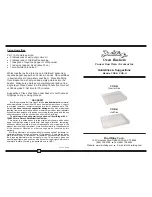
16
Preheating
When you need to preheat the oven, we recommend you do so for 10 minutes. For recipes needing high
temperatures, e.g. bread, pastries, scones, soufflés etc., best results are achieved if the oven is preheated first.
For best results when cooking frozen or cooked chilled ready meals always preheat the oven first, unless the
cooking instructions advise you otherwise.
Cooking
• Ensure that food is placed centrally on the shelf and that there is sufficient room around the baking tray/dish
to allow for maximum heat circulation.
• Stand dishes on a suitably sized baking tray on the shelf to prevent spillage onto the oven base and to help
reduce cleaning.
• The material and finish of the baking tray and dishes used affect browning of the bottom of the food.
Enamel-ware, dark, heavy or non-stick utensils increase browning of the bottom of the food. Shiny aluminium
or polished steel trays reflect the heat away and give less browning of the bottom of the food.
• When cooking more than one dish in the oven, place dishes centrally on different shelves rather than cluster
several dishes on one shelf, this will allow the heat to circulate freely for the best cooking results.
• If you are cooking more than one tray of similar items, for example cakes or biscuits, swap the trays during
cooking or you can remove the top tray when the food is cooked and move the lower tray to the higher shelf
to finish cooking.
• Do not place baking trays directly on the oven base as it interferes with the oven air circulation and can lead to
burning of the food. Use the lower shelf position.
• During cooking, do not open the door unnecessarily as you will lose heat and your cooking results may
changed. Cooking times will be longer and energy use will be higher.
• At the end of cooking time, as in all other cooking processes; turn the control to the “0” position (off). Take the
cooking tray out and put it onto a safe place (NOT on the oven door) as it will be hot. Keep children away from
the hot oven during and after cooking, until it has completely cooled down.
Baking Tips
1. Always place baking tins in the centre of the wire shelf.
2. Make sure you use bakeware that is oven proof and suitable for your recipe.
3. Do not place bakeware too close to the rear of the oven wall.
4. You can influence the degree of browning by changing the temperature setting.
5. If a cake collapses after removing it from the oven:
• Use less liquid on your next attempt.
• Consider using a longer baking time or use a slightly lower temperature setting.
• During use, the outer and inner surfaces of the oven get hot. While opening the oven door,
step back to avoid the hot steam coming out of the oven. There may be a risk of burns.
• Always use oven gloves to remove and replace food in the oven.
LFTG90W14_IB.indd 16
09/02/2015 17:51
















































